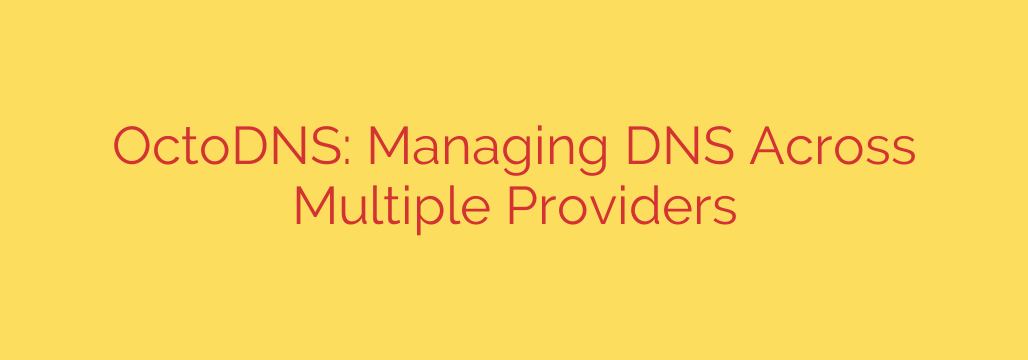
Streamline Your DNS Management Across Multiple Clouds with OctoDNS
Managing DNS records is a critical, yet often cumbersome, task for any organization. When your infrastructure spans multiple cloud providers—like AWS, Google Cloud, and Cloudflare—the complexity skyrockets. Each provider has its own unique interface, API, and terminology, leading to manual errors, configuration drift, and a significant time sink for your engineering teams.
Fortunately, there’s a powerful, modern solution to this problem: adopting a “DNS as Code” methodology with the open-source tool, OctoDNS. By treating your DNS configuration as code, you can bring automation, version control, and consistency to your entire DNS ecosystem.
The Challenge of Fragmented DNS Environments
In a typical multi-cloud setup, engineers often find themselves juggling multiple browser tabs to make a simple DNS change. This manual process is not only inefficient but also fraught with risk:
- Inconsistency: It’s easy for records to become out of sync between providers, leading to unpredictable application behavior or outages.
- Lack of Audit Trail: Who changed that A record? Why was this TXT record deleted? Without a proper history, troubleshooting becomes a nightmare.
- Manual Errors: A simple typo in a web UI can bring down a critical service. The risk of human error is always present.
- Vendor Lock-in: Relying heavily on one provider’s proprietary tools makes it difficult to migrate or add a secondary provider for redundancy.
These challenges highlight the need for a centralized, automated, and provider-agnostic way to manage DNS.
What is OctoDNS? The “DNS as Code” Solution
OctoDNS is an open-source tool, originally developed and used by GitHub, that enables you to manage your DNS records across multiple providers from a single, unified source of truth. At its core, OctoDNS allows you to define all your DNS zones and records in simple, human-readable YAML files.
These configuration files can then be stored in a Git repository, just like your application code. This approach unlocks several key benefits:
- Version Control: Every change to your DNS is tracked in Git. You get a complete history of who made what change, when, and why. Need to roll back a problematic update? It’s as simple as reverting a commit.
- Peer Review: Changes can be submitted through pull requests, allowing other team members to review them for accuracy before they go live. This simple step drastically reduces the chance of costly mistakes.
- Automation: By integrating OctoDNS into your CI/CD pipeline, you can automate DNS deployments entirely, eliminating the need for manual intervention.
How OctoDNS Simplifies Your Workflow
The genius of OctoDNS lies in its simple yet powerful workflow. The tool acts as an intelligent synchronization engine that ensures your live DNS configuration matches your desired state.
- Define Your Desired State: You create YAML files that declare all the records for a specific zone (e.g.,
your-company.com.yaml). This becomes your single source of truth. - Configure Providers: In a separate configuration file, you list all your DNS providers (e.g., Route53, Google Cloud DNS) and provide the necessary API credentials.
- Perform a Dry Run: This is perhaps the most critical feature. Before making any changes, you can run OctoDNS in a dry-run mode. It will connect to each provider, compare the existing records with your configuration files, and show you exactly what changes it plans to make (add, update, or delete).
- Sync Your Changes: Once you’ve reviewed the plan and are confident in the changes, you can run the sync command. OctoDNS will then connect to each provider’s API and execute the planned changes, bringing your live DNS configuration into perfect alignment with your source of truth.
This process is idempotent, meaning you can run the sync command multiple times, and it will only perform actions if there is a detected difference between your configuration and the live state.
Key Benefits of Adopting OctoDNS
Integrating OctoDNS into your operations provides immediate and significant advantages for security, reliability, and efficiency.
- True Provider Agnosticism: OctoDNS supports a vast ecosystem of DNS providers. This frees you from vendor lock-in and makes it trivial to run a multi-cloud DNS strategy for enhanced resilience.
- Enhanced Reliability and Disaster Recovery: You can easily configure a zone to be managed across two or more providers simultaneously. If your primary DNS provider experiences an outage, your secondary provider already has an identical, up-to-date copy of your records.
- Automated and Safe Deployments: Integrating with CI/CD tools like Jenkins or GitHub Actions allows for fully automated DNS updates. The mandatory dry-run step acts as a crucial safety net, preventing accidental deletions or incorrect updates.
- Elimination of Configuration Drift: With a single source of truth in Git, you can be certain that the DNS configuration for all your environments is consistent and accurate.
Security Best Practices for OctoDNS
As with any tool that manages critical infrastructure, following security best practices is essential.
- Secure Your API Keys: Never hardcode API credentials directly in your configuration files. Use a secrets management system like HashiCorp Vault, AWS Secrets Manager, or inject them as environment variables in your CI/CD pipeline.
- Apply the Principle of Least Privilege: When creating API keys or IAM roles for OctoDNS, grant them only the permissions required to manage DNS records. They should not have access to other parts of your cloud infrastructure.
- Mandate Pull Request Reviews: Enforce a policy where all DNS changes must be reviewed and approved by at least one other team member via a pull request. This human checkpoint is invaluable for catching errors before they impact production.
By shifting your DNS management to an “as code” model with OctoDNS, you can transform a once-risky, manual process into a streamlined, automated, and highly resilient part of your infrastructure. It’s a powerful step toward building a more scalable and efficient engineering organization.
Source: https://www.linuxlinks.com/octodns-manage-dns-across-multiple-providers/








